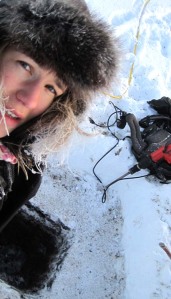What do Cookies, Soil Hydrology and Sweden Have in Common?
UAF scientist Anna Liljedahl!
A couple weeks ago, Anna Liljedahl visited with a group of high school students out at the Barrow Environmental Observatory as a part of BASC After School Field Trip program. Anna is a researcher from the University of Alaska Fairbanks and has been coming up to Barrow for a number of years to study hydrology of ice-wedge polygons in the tundra.
Upon first arriving out to the site, Anna split the group of high schoolers into two teams and gave each group a cookie. She asked the students to place that cookie in “the warmest spot on the tundra.” Then Anna measured the temperature of the two spots chosen by the students, one near the surface of the snow and the other under 2 feet of snow. The temperatures differed by a staggering 10 degrees Celsius! Anna explained how the thick layer of snow actually acts as insulation for the tundra, so the cookie placed two feet down and out of the wind was in a much warmer spot than the other cookie placed near the surface.
Anna, who is Swedish, also used Swedish chocolates to demonstrate how water flows through polygon features on the surface of the tundra. It was quite a fun and tasty trip, since the students got to eat the chocolate polygons after the demonstration!

Anna Liljedahl Digging in the Permafrost
But what does all of this have to do with Anna’s research? Here is a brief description, in her own words, of what Anna is looking at here in Barrow and why we will be seeing her again in the spring:
“This research aims to define the present hydrology and its controls, illuminating how wetlands underlain by continuous permafrost may respond to a changed climate. The simulations have shown that ice-wedge polygon features play an important role in controlling both the ponding of water on the surface and the amount of runoff to the ocean.”

Leave a comment